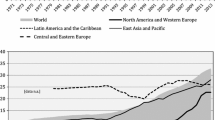Abstract
Recent Government policy has been strongly in favour of encouraging entrepreneurship and partnerships with industry. A flagship project backed by £68 m was launched by Gordon Brown as Chancellor of the Exchequer in 1999. Due diligence exercises by the DTI failed to ensure that value for money was obtained. What had been planned and announced as an educational charity became a Limited Company and the ban on using the money for commercial spin-outs was waived. There was imperfect quality control of projects and little control over costing. There appear to be funding lessons both for Government and for universities at a time when it is proposed to charge students top-up fees, for the sum given away by the Treasury here for one badly-supervised project represents the top-up fees of over 20,000 students.
Similar content being viewed by others
Notes
Collaboration between the University of Cambridge and the Massachusetts Institute of Technology: Notice, Cambridge University Reporter, 8 November 1999. The Cambridge University Reporter may be read on the web at www.cam.ac.uk. A version of some of this material appears in G.R. Evans, The Cambridge Business (Edwin Neven Press, 2004) forthcoming.
Joint Report of the Council and the General Board on the Cambridge–MIT Institute, Cambridge University Reporter, I March 2000.
Cambridge University Reporter, 22 March 2000.
Collaboration between the University of Cambridge and the Massachusetts Institute of Technology: Notice, Cambridge University Reporter, 8 November 1999.
Joint Report of the Council and the General Board on the Cambridge–MIT Institute, Cambridge University Reporter, 1 March 2000.
Joint Report of the Council and the General Board on the Cambridge–MIT Institute, Reporter, 1 March 2000. ‘Of the £84 million (£68 million from the public sector via the HMT Capital Modernisation Fund and £16 million from the private sector in the UK), £36 m is likely to be committed to integrated research, £20 m to undergraduate student education, £20 m to professional practice programmes, and £8 m to a national competitiveness network, the Cambridge Entrepreneurship Centre, and the administration of CMI.’
MIT web page 10 November 1999.
The Sunday Times, 14 November 1999.
Cambridge University Reporter, 6 June 2001.
Cambridge University Reporter, 22 March 2000.
Munro, Reporter 24 January 2001, p. 387.
At that time, David Livesey was Cambridge's Secretary General until his early retirement in 2003.
Cambridge University Reporter, 22 March 2000.
Cambridge University Reporter, 22 March 2000.
Ffowcs-Williams, Master of Emmanuel College, Cambridge University Reporter, 22 March 2000.
Joint Report of the Council and the General Board on the Cambridge–MIT Institute, Reporter, 1 March 2000.
Joint Report of the Council and the General Board on the Cambridge–MIT Institute, Reporter, 1 March 2000. Lord Trotman inexplicably appeared as Chairman, though this proposal was never put to Cambridge's Council.
Reporter, 21 February 2001.
Reporter, July 2001, p. 1013 Discuss in October ref.
‘The Council have been advised that it has not proved possible to establish the Cambridge–MIT Institute as an exempt charity as proposed in Recommendation I. The main reason for this is that MIT is not a UK charity. The Institute is jointly owned by Cambridge and MIT and is therefore not under the majority control of UK charitable trustees as is required by the Charity Commissioners. Experience to date, however, has confirmed that not being an exempt charity does not alter significantly the operation of CMI. The Council are therefore submitting a Grace to the Regent House to reflect this change’ (Grace, 2, 127). Cambridge University Reporter, 25 October 2000.
Cambridge University Reporter, 25th April 2001.
Cambridge University Reporter, 11 July 2001.
Cambridge University Reporter, 11 July 2001.
Reporter, 22 March 2000.
‘The University of Cambridge and MIT will initiate a series of common courses (typically to be taken by third-year students who will spend their entire third year at the host university) taught simultaneously at both locations as part of the degree programmes of the two universities. These will focus on engineering, science, technology, and management, including innovative interdisciplinary programmes, and will use distance learning technologies and web-based instructional materials’ Collaboration between the University of Cambridge and the Massachusetts Institute of Technology: Notice, Cambridge University Reporter, 8 November 1999.
The Graduate Studies Prospectus 2003–4, says of CMI Ltd, ‘The Cambridge–MIT Institute’ that it is ‘a strategic alliance’. ‘Its mission is to undertake education and research designed to improve the UK's entrepreneurship, productivity and competitiveness’. ‘It is envisaged that CMI will encourage the growth of spin-outs in the UK’. CMI also has sponsorship from industrial partners, currently BT and BP. Common courses at undergraduate and postgraduate level are being created, including three new MPhils in this Prospectus.’ ‘This course will draw on a range of modules from several departments in Cambridge and also MIT Master of Engineering (MEng) programme that has been very successful’.
A Welcome from the Vice-Chancellor, Graduate Studies Prospectus, 2003–4. ‘The Board also considered proposals for two new MPhil courses developed as part of the CMI project, in Biosciences Enterprise and Technology Policy’. Board of Graduate Studies Annual Report 2001.
Reporter, 22 March 2000.
Collaboration between the University of Cambridge and the Massachusetts Institute of Technology: Notice, Reporter, 8 November 1999.
Cambridge University Reporter r, 22 March 2000.
Collaboration between the University of Cambridge and the Massachusetts Institute of Technology: Notice, Reporter, 8 November 1999.
Cambridge University Reporter, 25 July, 2001.
Reporter, 7 June, 2000, p. 767.
Collaboration between the University of Cambridge and the Massachusetts Institute of Technology: Notice, Cambridge University Reporter r, 8 November 1999.
Joint Report of the Council and the General Board on the Cambridge–MIT Institute, Reporter, 1 March 2000.
Cambridge University Reporter, 22 March 2000.
Seventh Report of the Board of Scrutiny, Cambridge University Reporter, 7 August 2002, (=BoS 7), BoS 7 (47).
BoS 7 (47).
BoS 7 (47).
BoS7, Recommendation V.
Cambridge University Reporter, 22 March 2000.
Author information
Authors and Affiliations
Rights and permissions
About this article
Cite this article
Evans, G. Due Diligence, Higher Education Funding and CMI Ltd. High Educ Policy 17, 89–99 (2004). https://doi.org/10.1057/palgrave.hep.8300043
Published:
Issue Date:
DOI: https://doi.org/10.1057/palgrave.hep.8300043




